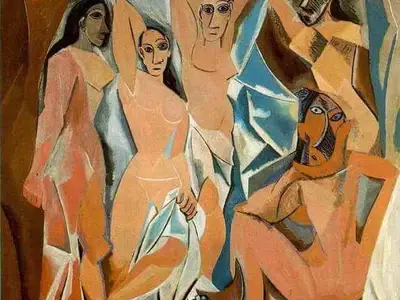Title of Artwork: Les Demoiselles d’Avignon

Artwork by Pablo Picasso
Year Created 1907
Summary of Les Demoiselles d’Avignon
The most well-known example of cubism art, Les Demoiselles d’Avignon, was created in 1907 and painted by Pablo Picasso. In this painting, Picasso made a clean break with all convention, abandoning the formal rules of depiction. In challenging the convention of idealised feminine beauty, he used creative liberties, including the deformation of the female form and geometric shapes. And, it demonstrates how Picasso was influenced by African art.
It took nine months to create this artwork, which is over six feet tall. The level of emotion shown by Picasso really comes through well. In order to finalise his final project, he made hundreds of drawings and studies. There are those who believe that the picture was a response to Le bonheur de vivre and Blue Nude by Henri Matisse.
All About Les Demoiselles d’Avignon by Pablo Picasso
The similarities to paintings by Cezanne, Gauguin, and El Greco have long been a popular topic of discussion for critics. Many people felt that the artwork was offensive when it was originally shown in 1916. When the painting was originally produced, Picasso called it “The House of Avignon,” but during the show, his friend and critic Andre Salmon used “The Young Ladies of Avignon” as the name so as to avoid offending the public. As a compromise, Picasso would have preferred using “the Avignon girls” in place of Salmon’s original title.
Leo Steinberg, an art critic and commentator, published a substantial essay in 1972 that thoroughly detailed the many creative expressions artists produce. For decades, previous examples of the style’s development were neglected, so he sought to convince others that, instead of seeing it as proof of an artist going through a brief change in expression, the assorted styles should be regarded as a deliberately devised, conservative presentation designed to capture the public’s attention. He sees that all of the women seem fearful and unconnected with each other. Rather, they simply stare at you, their odd styles only accentuating their strength.
The stare that is both confrontational and female in Olympia, 1863 is believed to have had a profound effect on Manet’s work. This had important implications in his other paintings of strong women, most notably in Olympia.
This multitude of styles exists inside the work, and people endeavour to record this for the critical debate that has occurred over the years. For more than five decades, it has been viewed as a fact by Alfred Barr, the founding director of the Museum of Modern Art in New York City and one of the most respected commentators on the history of art, who linked Picasso’s prior work to Cubism, a style Picasso would help design and mature over the following five or six years.
Information Citations
En.wikipedia.org, https://en.wikipedia.org/.
























